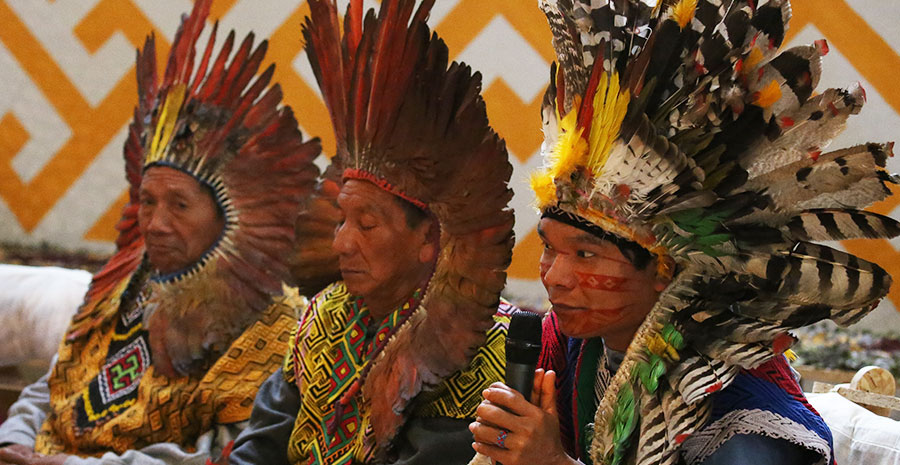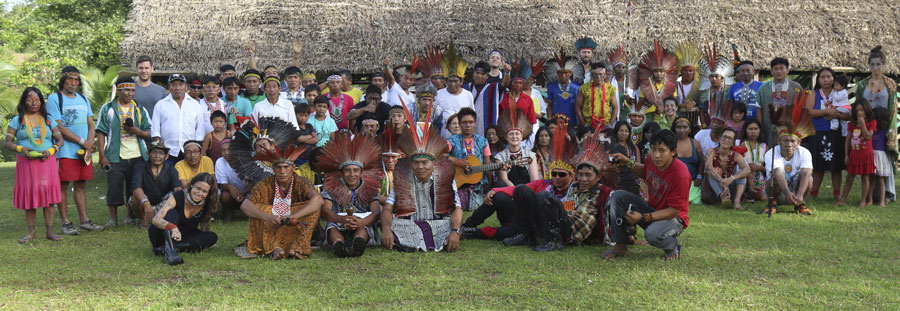The Rise of the Phyto Age engages with the Amerindian Huni Kuin’s oral ancestral knowledge of healing plants and their sacred spiritual philosophy, published in the Una Isĩ Kayawa (Book of Healing). Initiated by pajés (shamans) of the Huni Kuin from the Jordão and Tarauacá region and the Brazilian artist Ernesto Neto, the symposium fuses age-old Amazonian medicine and curing rituals with European healing traditions and contextualizes anthropological and ethnobotanical perspectives as well as exploring the ecological, economic, and politic al dimensions of the cultivation of teacher plants. The two-day symposium is an exceptional gathering of voices and insights, that aims to further open up discussion of the cultural relations of indigenous peoples and the cultivation, consumption, and distribution of their sacred plants, which have become highly politicized.
PROGRAM
Friday, June 26, 2015
6–10 pm, Ephemeropteraæ stage
Sacred Healing
Pajés of the indigenous Huni Kuin people inaugurate the symposium with ceremonial songs and dances and share insights about their healing practices.
Participants: Txana Bane, Sabino Ixã, Dua Buse, Ayani Huni Kuin, Tadeu Siã, Lauro Iasã, Siã, Sávio Kixtin, and Edinaldo Kaxinawa.
Una isĩ Kayawa
Initiation of the Una Isĩ Kayawa (Book of Healing) by the Huni Kuin, the publisher Anna Dantes and Alexandre Quinet (from the Botanical Garden Research Institute of Rio de Janeiro).
Pirjo Kristiina Virtanen: (Re)establishing Relations
The social anthropologist Pirjo Kristiina Virtanen provides an introduction to the Huni Kuin’s socio-philosophy and their healing practices that stimulate relationships between human and nonhuman subjects established through the use of certain herbal substances, chanting, or paintings that cause the spirits to materialize, enabling healing transformations.
Ricardo Luiz Narciso Moebus: Integrative Practices and Symmetrical Health
The symmetrical health proposal tries to absorb the contributions of symmetrical anthropology, as proposed by Bruno Latour, a reverse anthropology, and to apply it to the field of caring practitioners, recognizing indigenous knowledge and curing practices as having their own rationality, technologies, methodologies, teaching tools, production of knowledge, and calculations. This is an opportunity for a richer and more promising variation of ways of thinking, feeling, and experiencing care and life.
Roundtable discussion with Alexandre Quinet, Ricardo luiz Narciso Moebus, Dua Buse, Savio Kixtin, Lauro Iasã, and Sabino Ixã.
Saturday, June 27
10 am–6 pm, Ephemeropteræ stage (outside)
Introduction by Daniela Zyman und Alexandre Ehrmann
10 am–12 noon
Asclepius and Jiboia: Traditional and Contemporary European Healing Practices
Alexander Ehrmann (pharmacist, Saint Charles Apotheke, Vienna), Karl-Heinz Steinmetz (theologian, philosopher, and historian) and Philipp Furtenbach (artist, collective AO&) share their experiences and give insights into the history and living practices of the healing arts in Europe.
Alexander Ehrmann: The Human Being as/Is a Part of Nature
In the healing encounter with nature, medicinal herbs can teach us, in a very sensitive way, the basic elements and elementary powers of creation. Alexander Ehrmann describes how the communion with nature and the mindful performance of its processes can induce healing and help achieve a more balanced life and natural rhythm.
Karl-Heinz Steinmetz: The mole with constipation—a psychosomatic contribution to claustral medicine
In European Christian claustral medicine there are seven animal symbols that visualize psychosomatic congeries: the pig, the monkey, the mole, the bear, the dog, the donkey, and the lion. Using the example of the mole, physical and emotional interrelations can be studied and dissolved through specific physical and meditative exercises demonstrated during the presentation.
Philipp Furtenbach: AO& artists’ collective
Artist Philipp Furtenbach presents AO& artists’ collective’s project focusing on the engagement with so-called living systems, know-how about methods and techniques of treating and manipulating natural materials.
Discussion
The participants in the panel will discuss with the master pajés Dua Buse, Savio Kixtin, Lauro Iasã, and Ixã Sabinosimilarities and differences between European and Amazonian healing practices as well as the future of healing.
12–2 pm
Teacher Plants, Sustainability and Ancestral Futures
Marcelo Piedrafita Iglesias (anthropologist and researcher of Huni Kuin history, based in Rio Branco, Acre), Fabio Rubio Scarano (Brazilian Foundation of Sustainable Development), and Sarah Shenker (Campaign Leader for South and Central America at Survival International, the global movement for indigenous peoples’ rights) explain the intertwined relations between biodiversity, sustainability, and the preservation of natural resources and the habitat of the indigenous peoples of Brazil.
Fabio Rubio Scarano: “Regeneration cells” of Gaia: plant species as a source for healing the planet
The planet is undergoing an environmental crisis with rising levels of greenhouse gases in the atmosphere and unprecedented rates of species extinction. This talk will examine this scenario in light of James Lovelock’s Gaia hypothesis. This hypothesis postulates that earth is a living organism and defends the notion of the dynamic stability of life over time—whether or not humankind persists on the face of the planet. In two recent publications, Scarano and his coauthors have proposed that “regenerating cells” would be plant species able to “heal the scars” of Gaia.
Sarah Shenker: Facing New Challenges: Indigenous Peoples’ Rights in Brazil Today
The Amazon rain forest is home to hundreds of tribes, which have developed ways of living that are largely self-sufficient and extraordinarily diverse. They are guardians of the natural world and face catastrophic consequences unless their land stolen from them for resources, and labor force in the name of "progress" or "civilization." Sarah Shenker from Survival International will look into current law changes attempted in Brazil to further weaken indigenous peoples' control over their land, forms of resistance and a possible outlook for the future.
Marcelo Piedrafita Iglesias: Political Organization and Ancestral Futures
The presentation aims to highlight relevant features of the historical processes lead by the Huni Kui in the last decades, by which they gained official recognition for their indigenous lands, reorganized socially and politically, implemented strategies for managing their forest territories, resignified identity and cultural and ritual practices and are now constructing rich contemporary and future life projects, which imply multiple scales dialogues, interaction and travels.
3–5 pm
Phytomedicine: Legal Frameworks and (endangered) Intangible Cultural Heritage
Beatriz Caiuby Labate (social anthropologist and founder of Nucleus for Interdisciplinary Studies of Psychoactives [NEIP]), Benjamin De Loenen (founder of International Center for Ethnobotanical Education, Research & Service [ICEERS]), and Sebastian Scheerer (Sociologist and member of the Schildower Kreis) tackle the ritual use of Ayahuasca and other teacher plants, the preservation of intangible cultural heritage, and the questions of indigenous and human rights.
Bia Labate: Comments on Brazil's 2010 Resolution Regulating Ayahuasca Use
This talk provides an analysis of the process of and controversies surrounding the regulation of ayahuasca use in Brazil, from its first prohibition in the mid-1980s to its legalization for ritual and religious purposes to unfold how the recognition of the right to religious use of ayahuasca has influenced judicial decisions in several other countries.
Benjamin De Loenen: The Forward March of the Ayahuasca Initiative
As ayahuasca-drinking practices expand beyond the frontiers of the Amazon basin and media attention is increasingly drawn to this intercultural phenomenon, we face judicial, cultural, and social challenges: How can the rise of a practice involving the ingestion of such a potent concoction integrate constructively into our globalized world? For what is sacred to many is understood within the prohibitionist paradigm in our society, De Loenen describes the growing awareness of the important therapeutic and developmental benefits of ayahuasca.
Sebastian Scheerer (Schildower Kreis): From Conchita Wurst to Drugs and the Legal Disorder
The figure of a controversial Austrian drag queen exemplifies the relevance of the Kantian philosophy of freedom and the value of individual liberty as enshrined in Western constitutionalism, but it also serves as a yardstick to measure the distance between the rule of law, on the one hand, and the rule of drug laws, on the other. Drawing on overlapping cultural and social realms, Sebastian Scheerer explains how the global regime of prohibition of dangerous drugs could come into existence in the first place.
5:30–6 pm
Art and Healing: The Rise of the Python with Ernesto Neto, Anna Dantes, and TBA21 chief curator Daniela Zyman.
Discussion and Q&A.




































